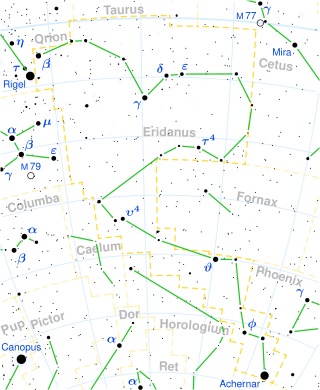HD 24160
HD 24160| 관측 데이터 에폭 J2000 이쿼녹스 J2000 | |
|---|---|
| 별자리 | 에리다누스 |
| 우측 상승 | 03h 49m 27.24527s[1] |
| 탈위임 | −36° 12′ 34.8771″[1] |
| 겉보기 크기 (V) | 4.17[2] |
| 특성. | |
| 스펙트럼형 | G7 III[3] |
| B-V색지수 | 0.927±0.045[2] |
| 아스트로메트리 | |
| 방사 속도 (Rv) | +2.0±0.7km[4]/s |
| 고유 운동 (μ) | RA: −44.841[1]mas/yr Dec.: -50.421마스[1]/yr |
| 시차 (π) | 15.0389 ± 0.22211[1] 마스 |
| 거리 | 217 ± 3 리 (66.5 ± 1.0 pc) |
| 절대치수 (MV) | 0.13[2] |
| 세부 사항 | |
| 미사 | 2.33[5] M☉ |
| 반지름 | 11[6] R☉ |
| 루미도 | 81.3[5] L☉ |
| 표면 중력 (log g) | 2.85±0.08[7] cgs |
| 온도 | 4,948±45[5] K |
| 금속성 [Fe/H] | +0.08±0.02[7] 덱스를 만들다 |
| 나이 | 1.76[5] Gyr |
| 기타 지정 | |
| 데이터베이스 참조 | |
| 심바드 | 자료 |
HD 24160은 에리다누스 적도 별자리에 있는 단일[9] 별이다.그것은 외견상 4.17의 시각적 크기로 육안으로 볼 수 있다.[2]HD 24160까지의 거리는 연간 시차 변화량 15.0 mas로 추정할 수 있으며,[1] 이는 217광년의 분리를 의미한다.그것은 지구로부터 +2 km/s의 태양 중심 방사상 속도로 더 멀리 이동하고 있다.[4]이 물체는 우르사 메이저 무빙 그룹의 코로나 구성원으로 우주에서 공통적인 움직임을 공유하고 있다.[10]
17억 6천만 살의 나이에 HD 24160은 G7 III의 별 분류를 가진 진화된 G형 거성으로,[3] 핵심에 있는 수소를 소비하고 주계열성으로부터 추적해 왔다.태양 질량의 2[5].33배, 태양 반지름의 약 11배까지[6] 확대됐다.이 별은 4,948K의 유효 온도에서 확대된 광권으로부터 태양의 81[5].3배의 광도를 발산하고 있다.[5]
참조
- ^ a b c d e f Brown, A. G. A.; et al. (Gaia collaboration) (August 2018). "Gaia Data Release 2: Summary of the contents and survey properties". Astronomy & Astrophysics. 616. A1. arXiv:1804.09365. Bibcode:2018A&A...616A...1G. doi:10.1051/0004-6361/201833051.
- ^ a b c d Anderson, E.; Francis, Ch. (2012), "XHIP: An extended hipparcos compilation", Astronomy Letters, 38 (5): 331, arXiv:1108.4971, Bibcode:2012AstL...38..331A, doi:10.1134/S1063773712050015, S2CID 119257644.
- ^ a b Keenan, Philip C.; McNeil, Raymond C. (1989), "The Perkins catalog of revised MK types for the cooler stars", Astrophysical Journal Supplement Series, 71: 245, Bibcode:1989ApJS...71..245K, doi:10.1086/191373.
- ^ a b de Bruijne, J. H. J.; Eilers, A.-C. (October 2012), "Radial velocities for the HIPPARCOS-Gaia Hundred-Thousand-Proper-Motion project", Astronomy & Astrophysics, 546: 14, arXiv:1208.3048, Bibcode:2012A&A...546A..61D, doi:10.1051/0004-6361/201219219, S2CID 59451347, A61.
- ^ a b c d e f g Luck, R. Earle (2015), "Abundances in the Local Region. I. G and K Giants", Astronomical Journal, 150 (3), 88, arXiv:1507.01466, Bibcode:2015AJ....150...88L, doi:10.1088/0004-6256/150/3/88, S2CID 118505114.
- ^ a b Pasinetti Fracassini, L. E.; et al. (February 2001), "Catalogue of Apparent Diameters and Absolute Radii of Stars (CADARS) - Third edition - Comments and statistics", Astronomy and Astrophysics, 367 (2): 521–524, arXiv:astro-ph/0012289, Bibcode:2001A&A...367..521P, doi:10.1051/0004-6361:20000451, S2CID 425754.
- ^ a b Alves, S.; et al. (April 2015), "Determination of the spectroscopic stellar parameters for 257 field giant stars", Monthly Notices of the Royal Astronomical Society, 448 (3): 2749–2765, arXiv:1503.02556, Bibcode:2015MNRAS.448.2749A, doi:10.1093/mnras/stv189.
- ^ "HD 24160". SIMBAD. Centre de données astronomiques de Strasbourg. Retrieved 2018-07-23.
- ^ Eggleton, P. P.; Tokovinin, A. A. (2008), "A catalogue of multiplicity among bright stellar systems", Monthly Notices of the Royal Astronomical Society, 389 (2): 869, arXiv:0806.2878, Bibcode:2008MNRAS.389..869E, doi:10.1111/j.1365-2966.2008.13596.x, S2CID 14878976.
- ^ Chupina, N. V.; et al. (June 2006), "Kinematic structure of the corona of the Ursa Major flow found using proper motions and radial velocities of single stars", Astronomy and Astrophysics, 451 (3): 909–916, Bibcode:2006A&A...451..909C, doi:10.1051/0004-6361:20054009.



